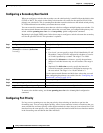
17-2
Catalyst 2960 and 2960-S Switch Software Configuration Guide
OL-8603-09
Chapter 17 Configuring MSTP
Understanding MSTP
This chapter consists of these sections:
• Understanding MSTP, page 17-2
• Understanding RSTP, page 17-10
• Configuring MSTP Features, page 17-15
• Displaying the MST Configuration and Status, page 17-28
Understanding MSTP
MSTP, which uses RSTP for rapid convergence, enables VLANs to be grouped into a spanning-tree
instance, with each instance having a spanning-tree topology independent of other spanning-tree
instances. This architecture provides multiple forwarding paths for data traffic, enables load balancing,
and reduces the number of spanning-tree instances required to support a large number of VLANs.
These sections describe how the MSTP works:
• Multiple Spanning-Tree Regions, page 17-2
• IST, CIST, and CST, page 17-3
• Hop Count, page 17-6
• Boundary Ports, page 17-6
• IEEE 802.1s Implementation, page 17-7
• “MSTP and Switch Stacks” section on page 17-9
• Interoperability with IEEE 802.1D STP, page 17-9
For configuration information, see the “Configuring MSTP Features” section on page 17-15.
Multiple Spanning-Tree Regions
For switches to participate in multiple spanning-tree (MST) instances, you must consistently configure
the switches with the same MST configuration information. A collection of interconnected switches that
have the same MST configuration comprises an MST region as shown in Figure 17-1 on page 17-4.
The MST configuration controls to which MST region each switch belongs. The configuration includes
the name of the region, the revision number, and the MST VLAN-to-instance assignment map. You
configure the switch for a region by using the spanning-tree mst configuration global configuration
command, after which the switch enters the MST configuration mode. From this mode, you can map
VLANs to an MST instance by using the instance MST configuration command, specify the region name
by using the name MST configuration command, and set the revision number by using the revision MST
configuration command.
A region can have one or multiple members with the same MST configuration. Each member must be
capable of processing RSTP bridge protocol data units (BPDUs). There is no limit to the number of MST
regions in a network, but each region can support up to 65 spanning-tree instances. Instances can be
identified by any number in the range from 0 to 4094. You can assign a VLAN to only one spanning-tree
instance at a time.


















